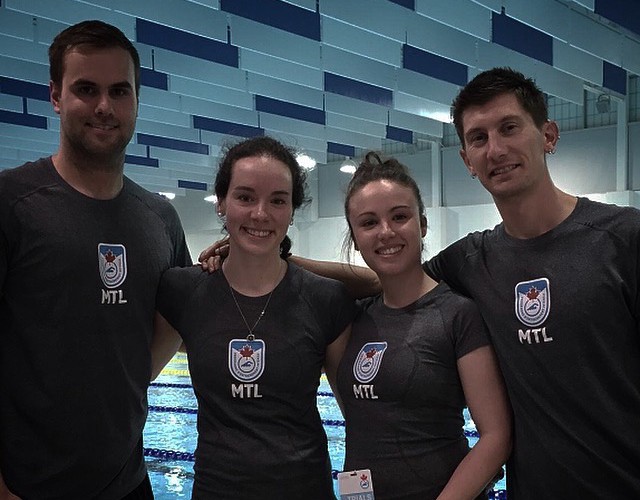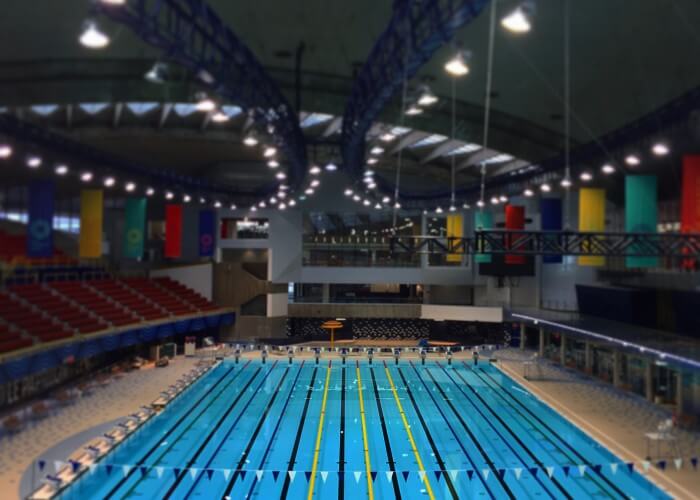Intensive Training Program Looks to Take Canadian Swimming to New Heights

By Matt Grillo, Swimming World College Intern
Tom Rushton became an integral part of a structure aimed at catapulting Canadian swimming to a new level when he was brought on to be head coach of the Intensive Training Program [ITP] in April of 2014.
The former Montreal High Performance Centre was officially closed on March 31, 2014. Following the closure, Rushton was hired to lead the charge for the new and improved Intensive Training Program.
“The biggest difference is the amount of funding,” Rushton said. “We don’t have as much funding as the former program did. We had no carded athletes this time last year, so we’re building that program up,”
The Intensive Training Program was put in place by Swimming Canada and works in close tandem with the Institut National du sport du Quebec [INS] in order to give elite athletes the necessary means to reach the podium at both the World Championships and the Olympic Games.
“Being able to get to the podium at the World Championships, get to the podium at the Olympic Games, that’s always the goal,” Rushton said.
The Intensive Training Program currently consists of six swimmers, who train out of the Olympic Park pool in Montreal. The INS complex is located within the venue at the Olympic Park. With approximately 150,000 square feet of space the Olympic Park is the training facility for eight national level sports (swimming, diving, waterpolo, synchronized swimming, judo, gymnastics, fencing and short-track speedskating).
The INS complex recently saw an upgrade. The completion of a construction project in May 2014 had a budget of $24.5 million and began in October 2013. The new space has granted the Intensive Training Program state of the art equipment.
Training Is Everything
The swimmers are equipped with two wireless underwater cameras. Both cameras can be placed anywhere in the pool, but one is typically placed on the side of the pool with the other camera positioned to face the swimmers as they swim towards the wall. Both cameras are on a time-delay system that projects onto a 60 inch TV and this delay allows the swimmer to watch what they just did in the pool.
The video is then placed into an application called SwimPro, which allows for further analysis while still watching it on the TV. The swimmer and coach can point out specific mistakes by drawing lines and making notes on the screen.
“We have a camera and a TV out, so even if he (Rushton) is working with another athlete we’ll be able to get feedback right away,” Ashley McGregor, a member of the Intensive Training Program at INS, said.
The six-person group trains primarily out of a five-lane, 50-meter pool. If the group feels they need the extra space, they can switch to the main competition pool which is a 10-lane, 50-meter Myrtha pool with the width of the pool spanning 25 meters. The 25 meter width has 16 Omega starting blocks while the long course version has 20 Omega starting blocks, 10 on each side of the pool.
The weight room and gym are a combined 15,000 square feet equipped with squat racks, over a dozen stationary bikes, a handful of treadmills and an area for massage therapy.
Alongside the weight room and gym there is an assortment of testing rooms. Primarily for VO2 max and body composition testing, these tests allow the athlete to gauge what type of physical condition their body is in.
A recovery room is also available for the athletes. The room has a large cold tub, which the swimmers typically use on Friday as a way to recover from the week.
They can also make use of the sleep lab. The athlete can rent a room in the lab free of charge and sleep on a bed, which monitors the athlete’s vitals.
“There’s a sleeping room which is absolutely amazing,” Barbara Jardin, a member of the Intensive Training Program, said. “You can basically just stay there all day. We have microwaves so you can heat up your food. We have an athlete’s lounge where you get to talk to a bunch of other athletes.”
Six swimmers, six different programs
Although all six swimmers share the common feature of wanting to be on the podium, a requirement for joining the team, each swimmer has their program specifically designed for their events.
“We don’t really have an average athlete. Everyone has their own schedule, so it’s very much an individualized program,” Rushton said.
The commitment that the Intensive Training Program requires is something that few athletes can handle. According to John Atkinson, the director of high performance at Swimming Canada, there are no concrete rules to joining the program. However, there are certain qualities that a swimmer must have.
If the swimmer has been a national team member, they will have the opportunity to join the Intensive Training Program. Additionally, if a younger swimmer is deemed to be on track towards reaching the podium, they can also have the possibility of joining the team. Regardless, the swimmer must commit to the program and the coach.
Each athlete will train in the morning for two hours between 8 a.m. and 10 a.m. Once training is complete, they can relax in their own athlete lounge. Between 10 a.m. and 1:30 p.m. the athletes have down time where they can complete homework or meet with some of the support staff. Each athlete is on a different path academically. Some take classes in the evening, while others only attend school in the morning– allowing them to make the afternoon practice times.
Training in the afternoon begins at 1:30 p.m. with weight sessions every Monday, Wednesday and Friday. On Tuesday and Thursday the athletes do more of a dryland-type training which consists of either pilates or fitness work. The athletes are then in the water from 3 p.m. to 5 p.m.
“I feel that because of the facility we’re able to do a much bigger volume of training,” Rushton said. “We could do 12 sessions in a week because we swim later and because the athletes don’t have to commute; they can stay upstairs and be ready to go.”
When it’s time to hit the water, each athlete has their own day-by-day schedule printed out on the whiteboard next to every practice. This schedule tells the athlete what type of practice they will be doing for each day along with what meets they have coming up.
On the reverse side of the board, the athlete has their best events broken down by 50 so that the event can be analyzed 50 meters at a time. Each 50 is then further divided into the start [first 15 meters], the middle [next 30 meters] and the finish [last 5 meters]. The times for each segment are compared against the average time for the top 16 in the world.
“Swimming here with Tom, he’s really detail-oriented,” McGregor, the Texas A&M Aggie who placed seventh in the 200 breastroke at the 2015 NCAAs said. “Every 50 or 100 that we’re doing, he’ll give you feedback right away because we’re only six swimmers.”
Support

Photo Courtesy: Tom Rushton
From left to right: Joé Mainville-Tessier (strength & conditioning), Christin Sadler (massage therapist), Véronique Richard (mental performance), Tom Rushton (head coach).
In order to reach those world-class times the athletes must put in an extreme amount of work inside the pool and out. The access that the swimmers in the ITP have to an outside support staff is paramount to their success in the pool.
The support staff consists of: two physiotherapists, a strength and conditioning coach, a massage therapist, a nutritionist, a mental performance consultant, a physiologist, a biomechanist and a choice of three doctors.
There might not be any body on the team who truly understands the importance of the support staff more than Barbara Jardin.
In September 2014, Jardin was diagnosed with type 1 diabetes. Through her extensive work with the team’s nutritionist Alexia de Macar and the help from her MAKEACHAMP campaign, Jardin has been able to manage her diabetes.
“We have our one-on-one talks to go over strategies,” Jardin, who placed 10th at the 2012 London Olympics in the 200 freestyle, said. “During taper [we work on] how much you should eat, during hard workouts how much Gatorade you should drink. It’s definitely really important.”
Each member of the support staff plays an integral role in making sure the athlete is at their best physically and psychologically. The ITP is also fortunate enough to have some of the members travel with them to some of their more important meets and training camps.
Success
Through the use of the brand new INS complex, Rushton has been able to continuously grow the Intensive Training Program and achieve great results.
In a few weeks time, Rushton and Jardin will be heading to the FISU World University Games in Gwanju, Korea.
At the end of August, Rushton will head down to Singapore with his swimmer Mary-Sophie Harvey for the FINA World Junior Swimming Championships.
Additionally, another one of Rushton’s swimmers Liam Desjarlais will be competing at the open water World Cup meets that take place in Lac St-Jean and Lac Megantic in Quebec.
The work won’t stop after a busy summer, as Rushton has even bigger goals for the following season. With a new Paralympic Intensive Training Program set to begin next year, both programs will collaborate.
“What we’re actually doing in Montreal is very exciting for the future,” Atkinson said. “The longer term vision is that these two Intensive Training Programs will work a lot closer together and form a high performance centre post Rio.”
Rushton’s vision for the two programs and where they can go is similar to what Atkinson and Swimming Canada are looking for.
“For us, being an Intensive Training Program, building and bringing the para swimming program on is going to help us increase our budget and increase the program,” Rushton said. “Our objective is to be a high-performance centre by post [Olympic] trials 2016.”





Wow, it will be interesting to watch those swimmers!
Barb Jardin’s MakeAChamp campaign is; https://makeachamp.com/barbarajardin
Hell yeah